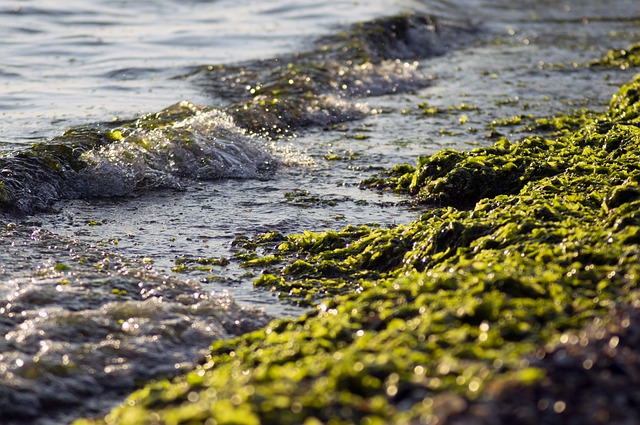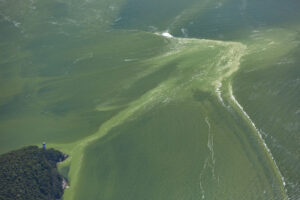Lauren Hansen, Staff Researcher/Writer
Have you ever visited Florida’s Gulf Coast only to find that beaches were closed and smell a fishy odor hanging in the air even a few miles inland? These are consequences of the so-called “Red Tide,” a harmful algal bloom (HAB) in the water. And there is more to this than meets the eye–and nose. Inconvenient at best, the effects of HABs on nature and nearby residents can be life-threatening. HABs are one of many disastrous consequences of ocean acidification, especially to marine life.
What is ocean acidification?
Ocean acidification is a growing problem affecting coastal communities and marine ecosystems, particularly in Florida. Ocean acidification (OA) means that ocean water chemistry is changing as it absorbs increasing amounts of carbon dioxide. The oceans on our planet have slowly become more acidic over the last 5,000 to 10,000 years. But with increased industrialization, this acidification has sped up to an unsustainable rate that we need to slow down.
What are the causes?
Oceans absorb carbon dioxide like a sponge. Emissions in the atmosphere from burning fossil fuels mean that our oceans are absorbing enormous amounts of carbon dioxide. Oceans absorb up to 30% of human-caused carbon dioxide emissions each year, with ocean plant life serving as a big part of this cleanup effort. Some types of algae help counteract OA by absorbing carbon dioxide. But if there is too much CO2, algae cannot keep up, and the water becomes more acidic. Human-related carbon dioxide is outpacing oceans’ absorption. Deforestation also contributes to more carbon dioxide in the air and in our oceans.
What are the effects?
The effects of ocean acidification are wide-ranging. Firstly, OA affects, among other things, seagrasses and marine macroalgae. Researchers in Japan have found in a study that ocean acidification keeps algae in a state of low biodiversity.
In addition to this, ocean acidification erodes coral reefs, such as those seen in the Florida Keys. As little as 2% of Florida’s original coral cover still remains. Coral reefs provide food security and shoreline protection, enhance tourism, and encourage biodiversity.
Lastly, ocean acidification is a contributing factor to harmful algal blooms (HABs) that affect our coastlines and those who live near them. HABs occur around the United States, and Florida is one of the areas that frequently sees HABs. Florida is particularly vulnerable to effects of climate change because of its low topography, extensive coastline, and frequency of large storms. The so-called Red Tide is a well-known type of HAB that affects its western coast.
Why do the consequences of ocean acidification matter?
Firstly, ocean acidification interrupts photosynthesis, nitrogen fixation, and reproduction in marine macroalgae. The health of these large seagrass meadows matters because they are home to many marine species. They filter out pollutants and serve as a building block for marine life.
Also, OA threatens healthy algal communities that are otherwise abundant in fish. It also prevents shelled species from forming and maintaining their shells. These include oysters, clams, sea urchins, and others. More than 1 billion people on the planet rely on marine life as a source of protein. OA disrupts the food supply for these communities and severely impacts the economy.
And finally, ocean acidification promotes HAB formation which compounds the negative consequences listed above. HABs have negative impacts on human health, the economy, and ecological systems. Depending on the algae species, HABs can be anywhere from minorly dangerous to potentially life threatening to humans. They can cause or worsen respiratory and gastrointestinal illnesses. Moreover, HABs require beach and fishery closures, which means loss of tourism and commercial revenue. HABs also produce toxins that can kill fish, dolphins, manatees, birds, turtles, and other wildlife. Lastly, HABs reduce oxygen levels in water and prevent aquatic plants from getting much-needed sunshine.
Based on the above, it is clear that the effects of ocean acidification touch everyone, especially those who live close to and rely on marine ecosystems.
What can we do to slow down ocean acidification?
We can’t completely halt or reverse the effects of ocean acidification. But since humans are major contributors to this issue, we do have the power to slow it down. This would give species time to adapt. Also, if we manage to reduce CO2 emissions, this will help algal habitats flourish again and restore marine biodiversity.
We can all do our part to reduce our carbon footprint:
- conserve water
- recycle
- carpool
- use public transportation (if available)
Nutrient pollution, or runoff agricultural waste, is a more direct human cause of HABs. Coastal communities should make an effort to reduce nutrient pollution:
- manage stormwater runoff
- set up Stormwater Treatment Areas (STAs) to filter out nutrients
- plant native vegetation
- properly apply fertilizer
- engage in organic gardening techniques and organic pest control practices






